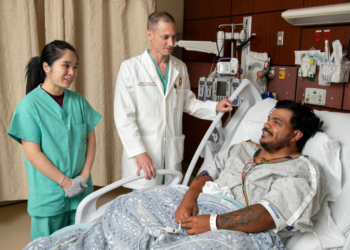Michaela and Elijah Dominguez weren’t expecting any surprises when, on a whim, they decided to get a 3D ultrasound 20 weeks into Michaela’s second pregnancy. Already the parents of an 18-month-old daughter, the Navy petty officer second class and his wife had been through it all before.
“I’m laying on the table, and my toddler’s holding my hand,” said Michaela. “And the tech is like, ‘I think I have mirror image on, because I’m seeing two.’ And my husband is looking at the screen like, ‘Oh my gosh, there are literally two heads.’”
The couple’s shock at discovering the twin pregnancy changed to fear once doctors discovered the Dominguez family was in the incredibly rare position of expecting monoamniotic-monochorionic (mono-mono) twins.
Mono-mono twins occur in approximately 1% of identical twin pregnancies and less than 0.1% of all pregnancies. They share both an amniotic sac and placenta, which leads to much higher risk than a typical pregnancy. Their umbilical cords can become entangled, leading to potentially fatal cord compression. The twins can also develop twin-twin transfusion syndrome, where blood is unevenly distributed between the twins and causes an imbalance in amniotic fluid, also a possibly fatal condition.
30% of mono-mono twins do not survive.
“The cord entanglement was so bad it looked like Celtic knots,” Michaela said. “I was going to the doctor every single day, with every appointment being an ultrasound appointment.”
Elijah had recently transferred to a new administrative position at Fleet Readiness Center Southeast in Jacksonville, Fla., and was initially concerned about how the stress of Michaela’s high-risk pregnancy would affect his work.
“But the assistant officer in charge pulled me aside and said, ‘Hey, Dominguez, I know that you’re new here … but we’re here for you, anything you need,’” Elijah said.
Michaela’s doctors already planned to deliver the twin girls by 34 weeks, so when they began to develop twin-twin transfusion syndrome at 32 weeks, Michaela had a scheduled cesarean section. Both twins spent 38 days in the NICU.
“They had a lot of growing to do,” said Michaela.
But now 10 months old, the twins are thriving, despite doctors warning Michaela and Elijah they would likely have developmental issues. “They’re crawling!” she said. “They’re pulling up on things!”
“They’re babbling,” Elijah added with a laugh.
“They’re doing everything they’re supposed to do,” said Michaela. “We got super lucky.”

Being in the Navy added to their luck from a financial perspective as well. The medical expenses would have been astronomical — almost $250,000 before insurance. But TRICARE coverage knocked the cost down to approximately $300 per twin.
Now living in San Antonio where Elijah is a Navy recruiter, the Dominguez family of five is healthy, happy and grateful for the support they received at Fleet Readiness Center Southeast.
“They were always checking up on both of us,” Michaela said. “There was never a moment where I felt bad about all these doctor appointments. They always made it a point to make all of us comfortable.”
Read comments








































